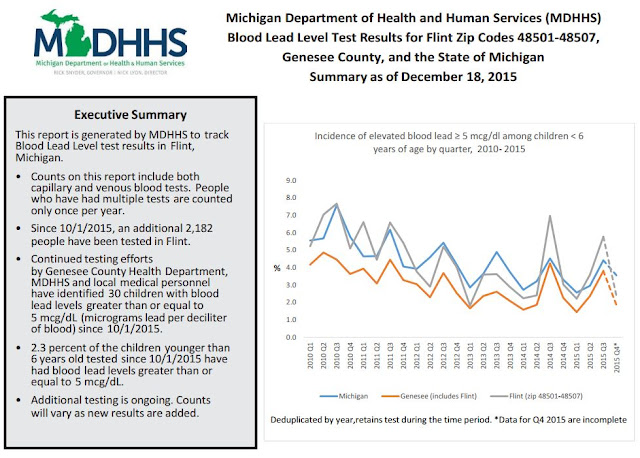A group of doctors led by Dr. Mona Hanna-Attisha of Hurley Medical Center in Flint urges the city to stop using the Flint River for water after finding high levels of lead in the blood of children. State regulators insist the water is safe. [source]On September 25th we get the "political football" email:
The DEQ (Department of Environmental Quality) and DCH (Department of Community Health) feel that some in Flint are taking the very sensitive issue of children's exposure to lead and trying to turn it into a political football claiming the departments are underestimating the impacts on the populations and particularly trying to shift responsibility to the state," said Muchmore. [source]All of this data coming in and the MDEQ and the MDCH - the agencies with public health responsibility - tell the Governor's man that it ain't their fault.
The wheels have come off and they all know it.
These dates on the timeline are when it can reasonably be assumed that it is known. It would be very odd that before that date parties that have something to do with this issue had no idea what was being looked at.
So let's look at blood-lead levels.
Before I knew about the work of Dr. Hanna-Attisha, I saw this table in the Detroit Free Press:
 |
| Detroit Free Press |
That's what I saw. That's what I see. And I was told this by the MDHHS:
Michigan Department of Health and Human Services spokeswoman Angela Minicuci told the Free Press on Thursday that the increase was "seasonal and not related to the water supply."Look at the graph MDHHS provided in September:
 |
| September 2015 |
I have looked at the data the MDHHS provides and I cannot make anything out as bad. Maybe I am missing it, but what they provided does not indicate a problem. And that, could be why they did not see it. The data is in there, but it is covered up and not obvious.
"This is definitely being driven by a little science and a lot of politics," Wes Priem, an Industrial Hygiene Manager with the Healthy Homes Section of the Michigan Department of Health and Human Services, said in September 2015.That's an interesting quote and tells you where there conventional wisdom was coming from.
In preparation for a late-September 2015 press conference and in response to data released by Edwards, Michigan Department of Health and Human Services Director Nick Lyon emailed fellow staff, "I would like to make a strong statement with a demonstration of proof that the lead blood levels seen are not out of the ordinary and are attributable to seasonal fluctuations."On Thursday night, I shared this thinking as well. But then I got some data...
"It wasn't until later that MDHHS epidemiologists took a more in-depth look at the data by ZIP code and confirmed an increase outside of normal trends,"
 |
| December 2015 |
Still...
January 23, 2016: The Michigan Department of Health and Human Services' own review last July showed a spike in blood-lead levels in Flint children in the months after the city switched its water supply to Flint River water. "If I knew then what I know now ... We needed a much more robust analysis," Dr. Eden Wells, Health and Human Services' chief medical executive, said Friday.Which brings me back to looking at this in contexts, as a whole. New water source, complaints, EPA Del Toral memo, lead found at the Walters home, Walters' kids with an increase in blood-lead levels. What more do you need to see to conclude that a closer look is necessary? that's not hindsight in my opinion.
"We should have torn it up and apart and gone up and down with that (data). That wasn’t done. "When I think about how Flint citizens have just had one thing after another — not just over the past two years, but many, many years — I wish that was not a missed opportunity." [source]There seems to be a lot of "golly, if I had only known!" coming from Michigan's governmental agencies responsible for protecting public health.
Enter Dr. Mona Hanna-Attisha of Hurley Medical Center in Flint.
Next post: Flint Water: A Political Football. Part 9
No comments:
Post a Comment